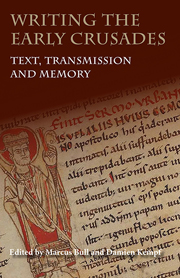Book contents
- Frontmatter
- Contents
- Acknowledgements
- List of Contributors
- List of Abbreviations
- Introduction
- Baldric of Bourgueil and the Familia Christi
- Guibert of Nogent, Albert of Aachen and Fulcher of Chartres: Three Crusade Chronicles Intersect
- Understanding the Greek Sources for the First Crusade
- The Monte Cassino Tradition of the First Crusade: From the Chronica Monasterii Casinensis to the Hystoria de via et recuperatione Antiochiae atque Ierusolymarum
- Nova Peregrinatio: The First Crusade as a Pilgrimage in Contemporary Latin Narratives
- What Really Happened to Eurvin de Créel's Donkey? Anecdotes in Sources for the First Crusade
- Porta Clausa: Trial and Triumph at the Gates of Jerusalem
- The Historia Iherosolimitana of Robert the Monk and the Coronation of Louis VI
- Towards a Textual Archaeology of the First Crusade
- Robert the Monk and his Source(s)
- Rewriting the History Books: The First Crusade and the Past
- The Ideal of Knighthood in English and French Writing, 1100–1230: Crusade, Piety, Chivalry and Patriotism
- Index
Porta Clausa: Trial and Triumph at the Gates of Jerusalem
Published online by Cambridge University Press: 05 May 2014
- Frontmatter
- Contents
- Acknowledgements
- List of Contributors
- List of Abbreviations
- Introduction
- Baldric of Bourgueil and the Familia Christi
- Guibert of Nogent, Albert of Aachen and Fulcher of Chartres: Three Crusade Chronicles Intersect
- Understanding the Greek Sources for the First Crusade
- The Monte Cassino Tradition of the First Crusade: From the Chronica Monasterii Casinensis to the Hystoria de via et recuperatione Antiochiae atque Ierusolymarum
- Nova Peregrinatio: The First Crusade as a Pilgrimage in Contemporary Latin Narratives
- What Really Happened to Eurvin de Créel's Donkey? Anecdotes in Sources for the First Crusade
- Porta Clausa: Trial and Triumph at the Gates of Jerusalem
- The Historia Iherosolimitana of Robert the Monk and the Coronation of Louis VI
- Towards a Textual Archaeology of the First Crusade
- Robert the Monk and his Source(s)
- Rewriting the History Books: The First Crusade and the Past
- The Ideal of Knighthood in English and French Writing, 1100–1230: Crusade, Piety, Chivalry and Patriotism
- Index
Summary
To cross the threshold is to unite oneself with a new world.
Arnold Van Gennep, The Rites of Passage
(London, 1960), p. 20As the sites which welcomed the prince, defied the enemy and regulated the passage of the merchant and traveller, the gateways and entrances (portae) of the eleventh-century west were markers and thresholds of community, power and sanctity. For the inhabitants of this gated world who took to the roads with the First Crusade, the portals of the cities and fortresses of the Near East represented important and recurring features in the landscape that they traversed. The gates that the crusaders encountered at the old Roman and Byzantine cities of Constantinople, Nicaea and Antioch were part of an urban architecture rendered on a scale few had ever experienced, evocative symbols of ancient authority and sacrality still bearing the marks of the triumphal military rulership of late antiquity by which they had originally been shaped. Nowhere, however, could the sight of gates have been as significant, and as eagerly anticipated, as at the holy city of Jerusalem itself.
Jerusalem and its sites were the central focus of Latin Christian devotion, and the city's urban geography was retraced in the imagination of believers as episodes from the life of Christ and the history of the Israelites were recited over the course of the liturgical year. The gates of Jerusalem and of its Temple are among the most common images in the Old Testament prophets and the Psalms.
- Type
- Chapter
- Information
- Writing the Early CrusadesText, Transmission and Memory, pp. 89 - 104Publisher: Boydell & BrewerPrint publication year: 2014

